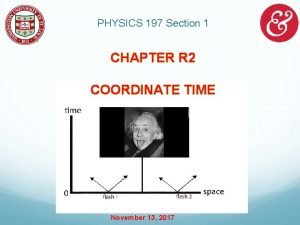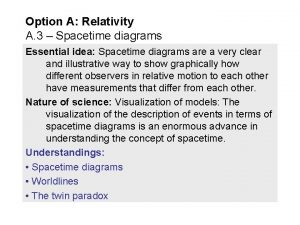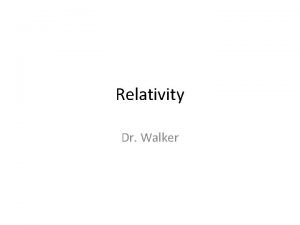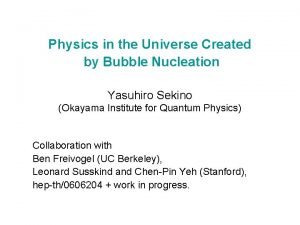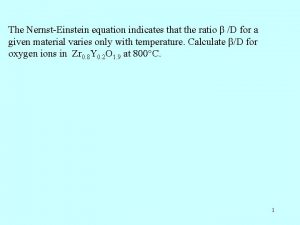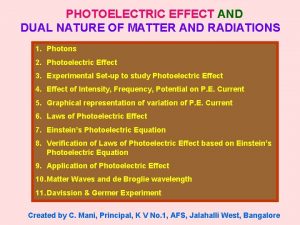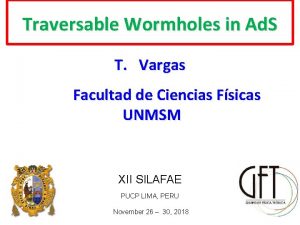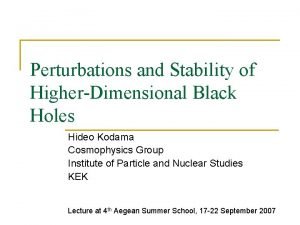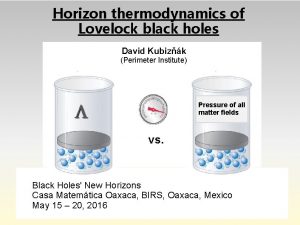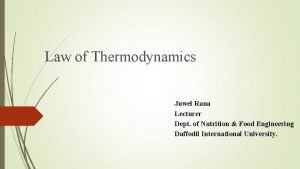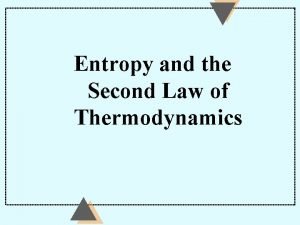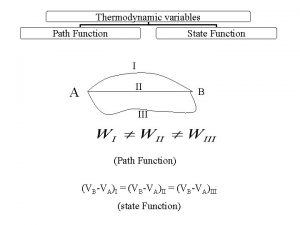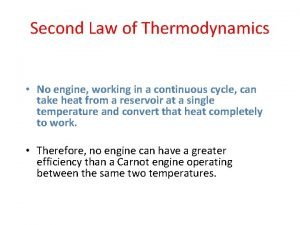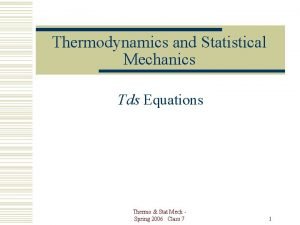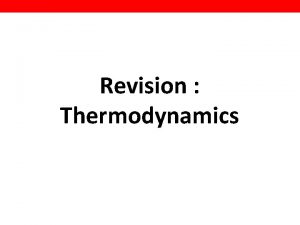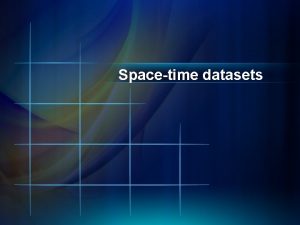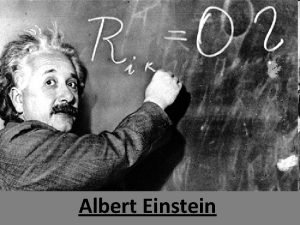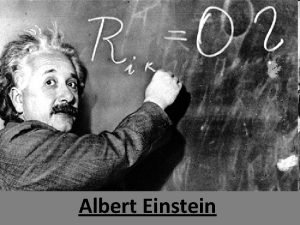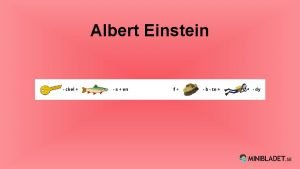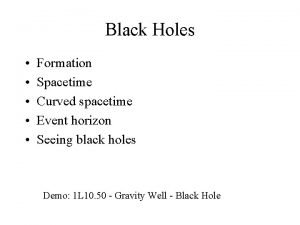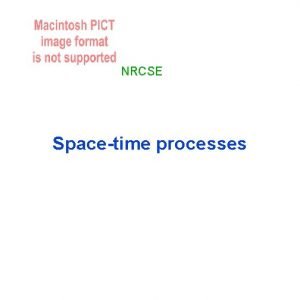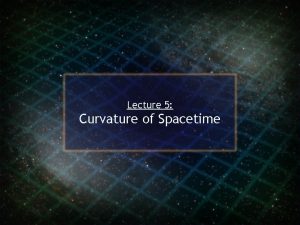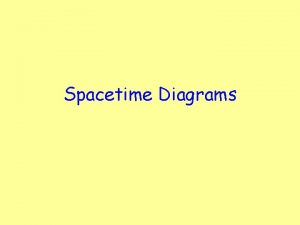Thermodynamics of Spacetime The Einstein Equation of State



















- Slides: 19

Thermodynamics of Spacetime: The Einstein Equation of State ar. Xiv: gr-qc/9504004 v 2 The Einstein equation is derived from the proportionality of entropy and horizon area together with the fundamental relation δQ = T d. S connecting heat, entropy, and temperature. The key idea is to demand that this relation hold for all the local Rindler causal horizons through each spacetime point, with δQ and T interpreted as the energy flux and Unruh temperature seen by an accelerated observer just inside the horizon. This requires that gravitational lensing by matter energy distorts the causal structure of spacetime in just such a way that the Einstein equation holds. Viewed in this way, the Einstein equation is an equation of state. This perspective suggests that it may be no more appropriate to canonically quantize the Einstein equation than it would be to quantize the wave equation for sound in air.

* With the discovery of Hawking radiation, it became clear that the four laws of blackhole mechanics is not just analoguous to those of thermodynamics, but the analogy is in fact an identitiy. * In this letter, the Einstein equations are derived from and horizon area together with the fundemental relation δQ = T d. S. Viewed in this way, the Einstein equation is an equation of state. It is born in thermodynamic limit as a relation between thermodynamic variables, and its validity is seen to depend on the existence of local equilibrium conditions.

* In thermodynamics, heat is energy that flows between degrees of freedom that are not macroscopically observable. In spacetime dynamics, we shall define heat as energy that flows across a causal horizon. It can be felt via the gravitational field it generates, but its particular form or nature is unobservable from outside the horizon. * For the purposes of this Definition, it need not be a blackhole of event horizon, it can be simply the boundary of the past of any set O. *We can consider a kind of local gravitational thermodynamics associated with such causal horizons , where the “system” is the degrees of freedom beyond the horizon. So we have a “causality barrier” between the system and the outside world (instead of a diathermic wall).

* That causal horizons should be associated with entropy is suggested b the observation that they hide information[3]. In fact, the overwhelming majority of the information that is hidden resides in correlations between vacuum fluctuations just inside and outside of the horizon[4]. * Because of the infinite number of short wavelength field degrees of freedom near the horizon, the associated “entanglement entropy” is divergent in continuum quantum field theory. If, on the other hand, there is a fundamental cutoffl ength l, then the entanglement entropy is finite and proportional to the horizon area in units of l^2, as long as the radius of curvature of spacetime is much longer than l. * Thus we shall assume from now on that the entropy is proportional to the horizon area (which is an extensive quantity).

* Recall that the origin of the large entropy is the vacuum fluctuations of quantum fields. According to the Unruh effect[8], those same vacuum fluctuations have a thermal character when seen from the perspective of a uniformly accelerated observer. We shall thus take the temperature of the system to be the Unruh temperature associated with such an observer hovering just inside the horizon. For consistency, the same observer should be used to measure the energy flux that defines the heat Flow. * In the limit that the accelerated worldline approaches the horizon the acceleration diverges, so the Unruh temperature and energy flux diverge, however their ratio approaches a finite limit. It is in this limit that we analyse thermodynamics, in order to make the arguments as local as possible.

Up to this point we have been thinking of the system as defined by any causal horizon. However, in general, such a system is not in “equilibrium” because the horizon is expanding, contracting, or shearing. Since we wish to apply equilibrium thermodynamics, the system is further specified as follows: The equivalence principle is invoked to view a small neighborhood of each spacetime point p as a piece of flat spacetime. Through p we consider a small spacelike 2 -surface element P whose past directed null normal congruence to one side (which we call the “inside”) has vanishing expansion and shear at p. It is always possible to choose P through p so that the expansion and shear vanish in a first order neighborhood of p. We call the past horizon of such a P the “local Rindler horizon of P”, and we think of it as defining a system—the part of spacetime beyond the Rindler horizon—that is instantaneouslystationary (in “local equilibrium”) at p. Through any spacetime point there are local Rindler horizons in all null directions.

CLAIM : The equilibrium thermodynamic relation δQ = T d. S, as interpreted here in terms of energy flux and area of local Rindler horizons, can only be satisfied if gravitational lensing by matter energy distorts the causal structure of spacetime in just such a way that the Einstein equation holds.


* Note that in a small neighborhood of any spacelike 2 -surface element P one has an approximately flat region of spacetime with the usual Poincaré symmetries. In particular, there is an approximate Killing field χa generating boosts orthogonal to P and vanishing at P. According to the Unruh effect, the Minkowski vacuum state of quantum fields—or any state at very short distances— is a thermal state with respect to the boost hamiltonian at temperature The heat flow is to be defined by the boost energy current of the matter.

* Consider now any local Rindler horizon through a spacetime point p. Let χa be an approximate local boost killing field generating this horizon, with the direction chosen to be future pointing to the inside past of P. Assume all the heat flow across the horizon is (bost) energy carried by matter. This heat flux to the past of P is given by: * The integral is over a pencil of generators of the inside past horizon H of P. If is the tangent vector to the horizon generators for an affine parameter λ that vanishes at P and is negative to the past of P, then : Where d. A is the area element on a cross section of the horizon.

* So the heat flux can be written as : Assume now the entropy is proportional to the horizon area, so we have: Where δA is the area variation of a cross section of a pencil of generators of H. The dimensional constant η is undetermined for now, but given a microscopic theory of spacetime structure one may one day compute it in terms of a fundemental length scale. The area variation is given by (θ being the expansion of the horizon generators) :

** The content of δQ = T d. S is essentially to require that the presence of the energy flux is associated with a focussing of the horizon generators. At P the local Rindler horizon has vanishing expansion, so the focussing to the past of P must bring an expansion to zero at just the right rate so that the area increase of a portion of the horizon will be proportional to the energy flux across it. This requirement imposes a condition on the curvature of spacetime as follows.

* The equation of geodesic deviation applied to the null geodesic congruence generating the horizon yields the Raychaudhuri equation: We have chosen our local Rindler observer to be stationary at P, so that expansion and shear vanishes at P. Therefore the first two terms are higher order contributions that can be neglected compared with the last term when integrating to find θ at P. For sufficiently small λ the integration gives: And substituting this into the equation for δA we get:


* The proportionality constant η determines Newton’s constant as Which identifies the length as

CONCLUSIONS, QUESTIONS Changing the assumed entropy functional would change the implied gravitational field equations. For instance, if the entropy density is given by a polynomial in the Ricci scalar, then δQ = T d. S will imply field equations arising from a Lagrangian polynomial in the Ricci scalar[9]. It is an interesting question what “integrability” conditions must an entropy density satisfy in order for δQ = T d. S to hold for all local Rindler horizons. It seems likely that the requirement is that the entropy density arises from the variation of a generally covariant action just as it does for black hole entropy. Then the implied field equations will be those arising from that same action.

Local temperature and entropy are not even well defined away from equilibrium. In the case of gravity, we chose our systems to be define. D by local Rindler horizons, which are instantaneously stationary, in order to have systems in local equilibrium. At a deeper level, we also assumed the usual form of short distance vacuum fluctuations in quantum fields when we motivated the proportionality of entropy and horizon area and the use of the Unruh acceleration temperature. Viewing the usual vacuum as a zero temperature thermal state[11], this also amounts to a sort of local equilibrium assumption. This deeper assumption is probably valid only in some extremely good approximation. We speculate that out of equilibrium vacuum fluctuations would entail an ill-defined spacetime metric.

Given local equilibrium conditions, we have in the Einstein equation a system of local partial differential equations that is time reversal invariant and whose solutions include propagating waves. One might think of these as analogous to sound in a gas propagating as an adiabatic compression wave. Such a wave is a travelling disturbance of local density, which propagates via a myriad of incoherent collisions. Since the sound field is only a statistically defined observable on the fundamental phase space of the multiparticle system, it should not be canonically quantized as if it were a fundamental field, even though there is no question that the individual molecules are quantum mechanical. By analogy, the viewpoint developed here suggests that it may not be correct to canonically quantize the Einstein equations, even if they describe a phenomenon that is ultimately quantum mechanical.

For sufficiently high sound frequency or intensity one knows that the local equilibrium condition breaks down, entropy increases, and sound no longer propagates in a time reversal invariant manner. Similarly, one might expect that sufficiently high frequency or large amplitude disturbances of the gravitational field would no longer be described by the Einstein equation, not because some quantum operator nature of the metric would become relevant, but because the local equilibrium condition would fail. It is my hope that, by following this line of inquiry, we shall eventually reach an understanding of the nature of “non-equilibrium spacetime”.
 Spacetime coordinates review
Spacetime coordinates review Spacetime diagram examples
Spacetime diagram examples Spacetime walker
Spacetime walker De sitter spacetime
De sitter spacetime Grothus law
Grothus law Nernst einstein equation
Nernst einstein equation Einstein equation for photoelectric emission is
Einstein equation for photoelectric emission is Einstein rosen bridge equation
Einstein rosen bridge equation Einstein black hole equation
Einstein black hole equation Black hole gravity equation
Black hole gravity equation Einstein black hole equation
Einstein black hole equation Isentropic compressor
Isentropic compressor Zeroth law of thermodynamics
Zeroth law of thermodynamics First law applied to flow process
First law applied to flow process State function in thermodynamics
State function in thermodynamics State vs path function
State vs path function Equation of second law of thermodynamics
Equation of second law of thermodynamics Usuf thermodynamics
Usuf thermodynamics Tds equation in thermodynamics
Tds equation in thermodynamics Thermodynamic formula sheet
Thermodynamic formula sheet
